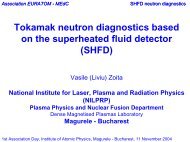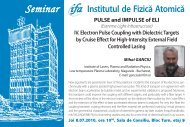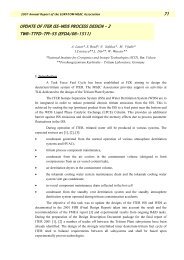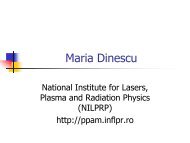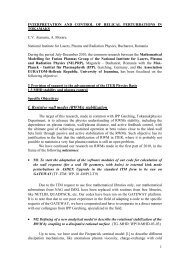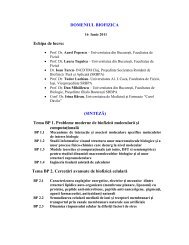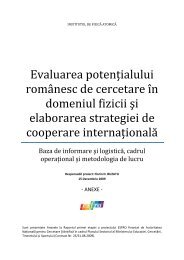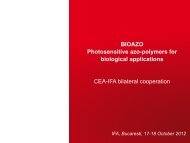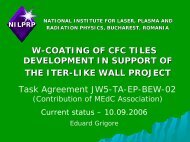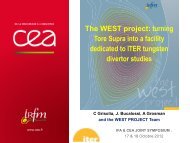EFDA Integrated Tokamak Modelling Task Force - IFA
EFDA Integrated Tokamak Modelling Task Force - IFA
EFDA Integrated Tokamak Modelling Task Force - IFA
You also want an ePaper? Increase the reach of your titles
YUMPU automatically turns print PDFs into web optimized ePapers that Google loves.
<strong>EFDA</strong> <strong>Integrated</strong> <strong>Tokamak</strong> <strong>Modelling</strong> <strong>Task</strong> <strong>Force</strong><br />
(status (status, what can be used?, used? development strategy)<br />
EFTC, Riga, 2009<br />
Presented by D. Kalupin<br />
on behalf of<br />
ETS team members and <strong>EFDA</strong>-ITM contributors<br />
TF Leader : P. Strand,<br />
Deputies: L-G. Eriksson, R. Coelho, G. Falchetto<br />
<strong>EFDA</strong> CSU Contact Person: D. Kalupin<br />
1
ITM-TF charge<br />
What is ITM-TF?<br />
• Co-ordinate the development of a coherent set of validated simulation<br />
tools toos for o ITER exploitation<br />
e potato<br />
• Benchmark these tools on existing tokamak experiments<br />
• Provide a comprehensive simulation package for ITER and DEMO<br />
plasmas.<br />
• Coordinate the European European p Software developments p with the aim to<br />
increase quality and reduce parallel efforts. (Streamline the code base)<br />
ITM Users benifits:<br />
ITM-TF Remit<br />
• Development of the necessary standardized software tools for<br />
• interfacing code modules and<br />
• accessing experimental data.<br />
Medium term activities<br />
• Support the development of ITER-relevant scenarios in current<br />
experiments.<br />
2
user<br />
ITM data storage<br />
Exp2ITM<br />
Import exp. data<br />
EExperimental i t ld data t<br />
EU tokamaks<br />
ITM<br />
Portal<br />
ITM<br />
Gateway<br />
ITM infrastructure overview<br />
Documentation<br />
Gforge<br />
Hotline (User Support)<br />
KEPLER<br />
Simulation<br />
worfklows<br />
GRID / HPC<br />
EGEE + DEISA<br />
UAL<br />
ISE<br />
FC2K<br />
CPO communication<br />
Data edition<br />
KEPLER actor<br />
lib libraries i<br />
Si Simulation l ti control t l<br />
generator t<br />
Data structure<br />
CPOs<br />
Conceptual definition<br />
Simulation<br />
catalogue<br />
Standardized code interfaces<br />
Physics y codes<br />
(from IMPs)<br />
Blue: part of the 2009 ISIP work program<br />
Broken arrows, thin boxes : not ready yet<br />
The rest is ready, at least in a first prototype version<br />
3
How ITM tools work?<br />
Th There are many codes d describing d ibi various i physics h i available il bl<br />
Usually, difficulties appear while codes are coupled<br />
N modules integrated in N modules coupled into a<br />
N different applications dynamic y application pp framework<br />
The data model – or ontology - is the key to providing a consistent framework!<br />
Strand, ITM General Meeting 2009<br />
Based on material from David De Roure<br />
4
ITM-TF data base<br />
• The ITM has invested many<br />
man years of effort in defining<br />
the data to be transferred<br />
between different classes of<br />
codes � Consistent Physical<br />
Objects (CPOs)<br />
• Can be used by modules<br />
programmed in different<br />
languages<br />
• These are defined f in XML and<br />
then language specific data<br />
structure descriptions are<br />
automatically generated<br />
• At the code level deal with<br />
derived data types<br />
• Using Kepler as the workflow<br />
engine<br />
5
Development stages<br />
6
Financial support:<br />
- <strong>EFDA</strong> priority support: 735 keuro in 2010;<br />
700 keuro in 2011<br />
- infrastructure support team<br />
- gateway implementation<br />
How do we support ITM<br />
developments?<br />
Learning support:<br />
- code camps p and training g sessions for ITM members<br />
supported by EURATOM mobility<br />
Next ITM general meeting will take place in Lisbon, at the<br />
Congress Centre of the Instituto Superior Técnico (IST),<br />
between the 13th and the 15th September 2010. Followed<br />
by the training sessions on the ITM tools scheduled for<br />
16th 16th-17th 17th September, September held at the Computer Centre of the<br />
Electronics Engineering Department of IST.<br />
7
What ITM tools can be used?<br />
!!! Available description and documentation on ITM server:<br />
https://portal.efda-itm.eu/portal/authsec/portal/itm/GFORGE<br />
!!! Available to user through version control repository:<br />
http://gforge.efda-itm.eu/svn/<br />
http://gforge.efda itm.eu/svn/<br />
8
Equilibrium and MHD codes<br />
Several equilibrium reconstruction codes are available to ITM<br />
users:<br />
• CHEASE : svn (copy at ITM), Kepler actor<br />
• CAXE : svn (to be copied to ITM), Kepler actor<br />
• HELENA : svn ITM, Kepler actor, manual<br />
• KINX : svn to be copied ITM ITM, Kepler actor actor, manual<br />
• ILSA : svn ITM, Kepler actor, manual<br />
• EQUAL : svn ITM, Kepler actor<br />
TTo be b done: d<br />
• verification : standard test cases to be run regularly<br />
• validation on JET data<br />
9
Comparison of equilibrium codes<br />
10
ICRH<br />
ECRH<br />
NEUTRALS<br />
EQUIL<br />
NEO<br />
ANOM<br />
ETS workflow<br />
ELM(t)<br />
SOURCE_COMBINER TRANSPORT_COMBINER<br />
Conceptual<br />
design g<br />
solver l 1<br />
solver 1<br />
solver 1<br />
ETS<br />
SAW<br />
TEETH<br />
EQUIL?<br />
ELM(c)<br />
EQ_INPUT<br />
11
Settings for the computations:<br />
Shot: 71827<br />
Time 52 - 152s<br />
NRHO 101<br />
Equations:<br />
Current equation – predictive (total current = 2.56 MA)<br />
! note that PSI does not evolve in this case case, as it is only<br />
computed by ESCO as output and not used by JETTO<br />
(current equation is solved for the safety factor, q)<br />
Ion density equation – predictive<br />
(boundary density = 1.5*1012 cm-3)<br />
Diffusion coefficient (radialy ( y constant) )<br />
D⊥ = 1 m2/s<br />
Particle source (radialy constant)<br />
Si = 5*1019 m-3s-1<br />
All other transport equations:<br />
interpretative (profiles from t=52 s.<br />
are kkept through h h the h computations) i )<br />
Equilibrium:<br />
from ESCO (called 50 times during time<br />
evolution)<br />
ESCO settings:<br />
D shape model<br />
Major radius = 287 cm<br />
Minor radius = 99 cm<br />
Elongation = 1.65<br />
Triangularity = 0.2<br />
Zaxis = 0<br />
Number of iterations = 50<br />
Geometrical radius = 295 cm<br />
Btor = 2.56 T<br />
ETS-JETTO comparison<br />
12
Types of Codes:<br />
- Linear Micro-instabilities<br />
- Neoclassical Transport<br />
- Turbulence<br />
IMP4: Transport Processes<br />
and Micro stability<br />
Most of codes are adopted to the ITM data base:<br />
- This forced code developers to agree on input/output;<br />
- Made benchmarking between various codes easy (main task for IMP4)<br />
Two simplified modules have been developed and integrated in<br />
ETS workflow:<br />
1e+20<br />
8000<br />
- ETAIGB;<br />
9e+19<br />
8e+19<br />
7000<br />
6000<br />
- NEOWES<br />
7e+19<br />
5000<br />
6e+19<br />
5e+19<br />
4e+19<br />
3e+19<br />
2e+19<br />
0 0.5 1 1.5 2<br />
1.1e+20<br />
1e+20<br />
9e+19<br />
8e+19<br />
7e+19<br />
6e+19<br />
5e+19<br />
4e+19<br />
3e+19<br />
2e+19<br />
0 0.5 1 1.5 2<br />
ni, m^-3 Ti, eV<br />
4000<br />
3000<br />
2000<br />
1000<br />
2200<br />
2000<br />
1800<br />
1600<br />
1400<br />
1200<br />
1000<br />
0<br />
0 0.5 1 1.5 2<br />
ni, m^-3 Ti, eV<br />
800<br />
600<br />
400<br />
0 0.5 1 1.5 2<br />
rho_tor, m rho_tor, m<br />
13
IMP5: Heating, Current Drive<br />
and Fast Particles<br />
A collection of codes developed within the <strong>EFDA</strong> Associations in the field<br />
of ECRH, LHCD, ICRH, NBI, alpha particles and fast particle interaction<br />
with instabilities are being integrated in the ITM framework.<br />
The goal is to have at least one module for each physics area at two<br />
levels:<br />
1.one basic and less detailed, enabling fast computations, providing, e.g.,<br />
sources for the ETS code code, ii.e., e profiles of absorbed power and driven<br />
current densities, dP/dV and Jcd 2.one advanced, but computationally expensive, enabling detailed<br />
computations of the distribution functions of electrons and ions during<br />
heating and current drive, ultimately incorporating non‐linear effects of<br />
instabilities.<br />
The ultimate goal is the self‐consistent simulation of heating and current<br />
drive in the presence of fast particle instabilities, in particular for ITER.<br />
14
Codes are being tested with inputs from<br />
with ETS simulations in the areas<br />
•electron l physics, h i EC andd LH iinteraction i<br />
•ion physics ICRH, and NBI interaction<br />
•fast particle interaction and related MHD<br />
instabilities<br />
ECRH&CD –GRAY code<br />
ITER‐like parameters, B0=5.3 T, R0=6.2 m<br />
equilibrium ilib i ffrom HELENA, profiles fil ffrom<br />
ETS<br />
IMP5: Heating, Current Drive<br />
and Fast Particles<br />
ICRH –FPSIMcode<br />
The simplified Fokker‐Planck code FPSIM for<br />
evaluating ion distribution functions<br />
distorted by ICRF has been adapted to<br />
4.08a data structures.<br />
It is at present p coupled p to a mock‐up p ICRF<br />
deposition code.<br />
(MW/m3 Power density ( )<br />
ICRF‐wave power deposition, red line, and FPSIM<br />
calculated collisional power transfer to ions and<br />
electrons<br />
The code has been tested stand alone with<br />
4.08a data structures and as a Kepler actor<br />
in 4.07b data structures.<br />
15
• ITM infrastructure is ready<br />
• Many codes are already adopted to the<br />
infrastructure<br />
• At the moment, main effort goes in to<br />
coupling of tools and V&V<br />
• ITM tools are started to be used for<br />
analysis of experiments<br />
Summary<br />
16



